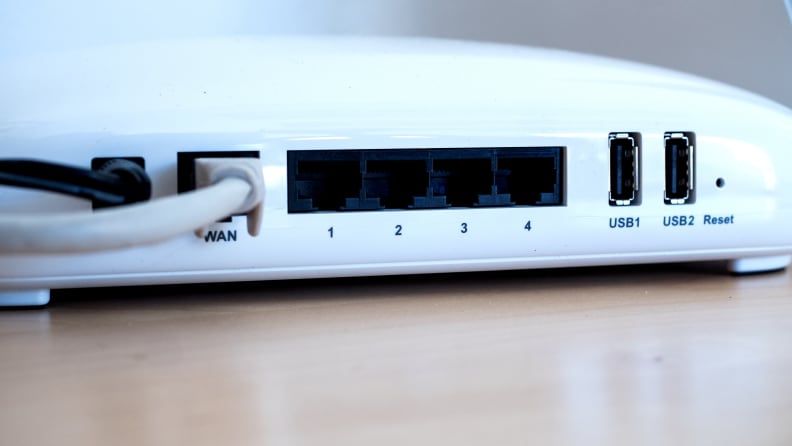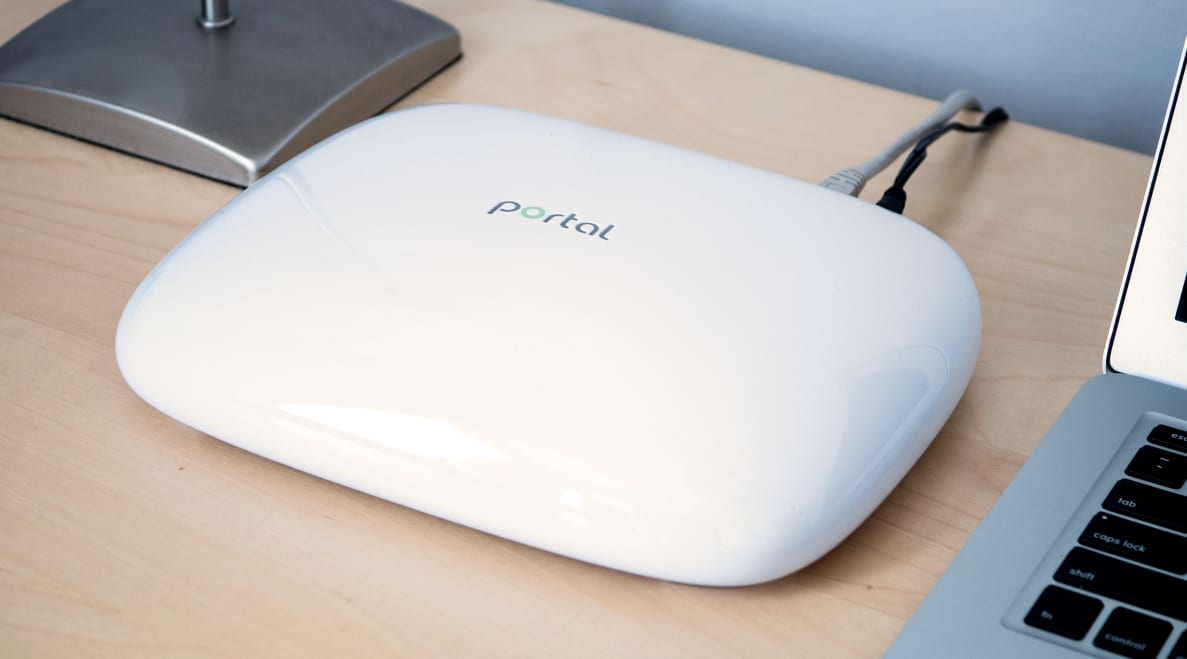Pros
Cons
That's because the WiFi signals sent from your router to your phone, laptop, and other devices travel on a narrow little segment of the radio spectrum. Like cars on the highway, data you’re requesting from your router can get stuck behind some data that your neighbors are requesting on their router.
The Portal WiFi router aims to address the city dwellers’ woes by opening up some previously inaccessible highway—like express lanes at rush hour.
I tried out the Portal router in two busy sections of Cambridge, MA, where the WiFi spectrum doesn't discriminate between the needs of MIT researchers and Netflix-binging grad students. In the end, the Portal router made good on all its promises and then some. But learning about what precisely happens under the hood only makes it that much cooler.
FastLanes: Opening up new lanes on the WiFi highway
Radio waves are all around us, and nearly all of them are designated for some application or another. The FCC doles outs the rights to various portions of the radio spectrum for radar, cellular data, Bluetooth, remote control cars, walkie-talkies… you name it. Only a few select portions—or channels—are available for WiFi routers.
{{ amazon name="Portal WiFi Router", asin="B01JQROZZS", align="right" }}But in densely populated cities, there are simply too many WiFi-connected devices trying to pass data back and forth across the same handful of channels.
Enter the Portal router.
The Portal router’s killer feature is that it uses portions of the spectrum that other, similarly priced routers can’t. Specifically, it can access four channels in the spectrum normally designated for military and commercial radar. Portal refers to these as its “FastLanes.”
For obvious reasons, airplane radar is mission-critical for safety, but actual occurrences of radar are infrequent. That means those channels are idle much of the time. So the Portal takes advantage of a technology called DFS (Dynamic Frequency Selection) to use those channels for your WiFi signal.
The moment an actual radar signal hits the channel, the Portal senses it, hightails it out of there for a period of time, and switches to one of the other three channels. If all four FastLanes are in active use for radar, the router just goes back to the normal channels that everyone else’s router is using.
An important caveat: The Portal router isn’t faster than other comparable routers. The maximum speed from your ISP is what it is. But by putting your data in previously unused lanes, you can actually drive at your ISP's top speed rather than sitting in traffic.
Expensive, enterprise-level routers have used DFS technology for a while, and now a few consumer routers are just starting to access some of these channels. But the Portal is the only consumer model that uses all four channels, which gives it a significant advantage.
How Well Does It Work?
I tried this router out in both my office and my home—each of which has over 20 competing WiFi signals within close range. The testing was ad hoc and not part of a rigorous roundup (look for that coming up soon), but I definitely put the Portal through its paces.
The takeaway: the Portal works as advertised. The slowest data speeds I ever clocked were on par with what I could normally expect from my Apple Airport Extreme at its best. The fastest, well… they were very fast. Upwards of 200Mbps.
Truth be told, though, a week after testing, I got those same great speeds with my old router—at least late at night on a weekday.
Download speeds are the result of an arcane blend of your ISP’s bandwidth, your router, the device your using to test the speed, and whatever other voodoo is in the air at any given moment. These finicky inexactitudes are why people hate their routers so much in the first place.
We can verify that the Portal router is at least as good as any similarly priced router we’ve tried. And while the FastLane technology is clever and advantageous in a crowded space, it’s not without its drawbacks when it comes to connecting all your WiFi-enabled devices.
{{ vimeo '165652061' }}
Set-up and Compatibility with Your Devices
Thanks a smartphone app that holds your hand through the whole process, the Portal router is dead simple to set up. It’s a welcome relief if you’re accustomed to the frustrating complexities of older routers.
Within a few hours of at-home testing, though, I confronted one of the downfalls of cutting edge WiFi technology: your network is only as fast as your slowest, least-compatible device.
Neither my Roku 4 nor my LG smart TV could connect to the default-setup Portal network because of compatibility issues. Ironically, these were the very two devices that begged for the best connections (i.e. my Netflix devices). In order to connect them, I had to go into the router’s settings and disable the FastLanes, thereby neutralizing the killer feature.
My iPhone 6s, MacBook Pro (late 2013), and iPad 3 had no problems, but that wasn't much comfort.
The Portal team is aware of these compatibility issues, but short of begging or forcing Roku, LG, and other manufacturers to issue simple firmware updates, there’s little they can do. Portal is confident that future products will be compatible with FastLanes, but the fact is that old products aren’t likely to get much love from their makers.

The Portal's design aesthetic is clean, elegant, and unobtrusive. All the antennas are tucked inside the shell. There are no blinking activity lights—just a steady green glow on top.
Portal Versus The Competition
The WiFi router space has gotten hot recently with the release of Eero, Luma, and Google WiFi mesh routers. Mesh solutions are bundles of routers (usually two or three, though they do work solo if need be) aimed at reducing dead spots in large houses or places where the architecture is working against the WiFi signal.
The Portal router is trying to solve a very different problem—living situations where your WiFi signal is getting drowned in a sea of competing WiFi signals.
If you face both these problems, multiple Portals routers can be meshed together on a single network. In fact, Portal has begun selling 2-pack bundles that are slightly cheaper than buying them separately.
Should You Buy It?
The Portal router is a high-performance, affordable router that anyone can take advantage of right out of the box. The design is simple and elegant. The 4x4 802.11ac antenna array is tucked discreetly under the plastic shell, as welcome relief from some of the spider-like eyesores on the market.
Thanks to easy setup, you get fast, reliable internet without a great deal of technical know-how. New support for mesh networks means that you can buy multiple Portal routers for the whole home to create a single network without dead spots.
The FastLane technology appears to offer a real advantage for people that live in high-density areas. And until all your neighbors also own a Portal router, it’s a way to get a little extra speed for not a lot of money.
On the downside, you may own some devices that can’t access the FastLanes (check here first). In certain cases, you may have to disable the FastLanes altogether. Without FastLanes, the Portal is a very good router, but it’s just another in a line of very good routers. And who knows? If you buy the Portal now, the other tech in your house may catch up over time and you can turn FastLanes back on.
If it’s time to upgrade your router, the Portal should absolutely be on your watchlist. It's not a perfect solution for every home, but it's a strong contender for us city folk.
Meet the tester
David Kender oversees content at Reviewed as the Editor in Chief. He served as managing editor and editor in chief of Reviewed's ancestor, CamcorderInfo.com, helping to grow the company from a tiny staff to one of the most influential online review resources. In his time at Reviewed, David has helped to launch over 100 product categories and written too many articles to count.
Checking our work.
Our team is here to help you buy the best stuff and love what you own. Our writers, editors, and experts obsess over the products we cover to make sure you're confident and satisfied. Have a different opinion about something we recommend? Email us and we'll compare notes.
Shoot us an email

